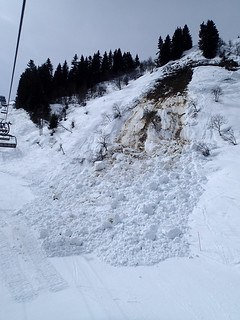Mini avalanche by FamilyRalph
P. Orin Zack by Philip Zack
In April 2013, Rob Kall wrote, "Sometimes small acts make huge things happen" you never know whether the something that YOU do could be the straw that breaks the camel's back, the action that shifts the power and becomes the tipping point." Rob's words reminded me of Derek Sivers' TED talk from 2010, and the video he showed that demonstrated how movements begin: it's not the leader that makes them happen, but the first follower. They also reminded me of Mark Buchanan's 2001 book, "Ubiquity", which focused on the critical state from which unpredictably large actions arise, and of "Cascade", a short story I'd written in 2008 about the difficulty of warning people about such events. After reading the comments to Rob's piece, I added my own, noting the power of first followers, and got on with my day.
That was six months ago. This morning, Mr. Kall invited me to expand on that comment about first followers and unpredictable event cascades. As it happens, I had returned to this thought just last month, in a short story called "Bait", so his adding that straw was enough to get me to spit out the thought on my tongue. And it was this: Immediacy is not important.
The critical state that Mark Buchanan wrote about is everywhere, including our language. Rob alluded to it with his remark about that last straw. The camel may be on the verge of collapse, and it wouldn't take much to bring it down, but it's not the weight of that straw which causes its fall. Each small nudge may have the potential to trigger the camel's downfall, but there's no way to predict which one it will be.
Imagine a steep pile of sand. The vibration of your footsteps or the nudge from a passing breeze is enough to cause one grain to slip against the next. If that second grain nudges a third, and so forth, you might notice a small change in one part of the pile. Another grain causes a tiny slide elsewhere on the pile, and then it's still again. Because the critical state is chaotic, there is no way to predict how much of an effect each of these slipped grains will have. Each grain gets a chance at the lottery. But then, one of the grains gets a winning ticket. When it slips, and others are jostled, the reaction continues, and the vibration from your footstep brings down a large portion of the pile.
That's how avalanches happen, regardless of whether the particles are sand, snow or boulders. With physical systems such as these, people with the right training and tools can recognize when a landslide or avalanche is immanent, and take action to mitigate the damage it might cause. One way to do this is to intentionally trigger a slide where and when it won't cause havoc, in order to relieve the stresses that had kept the hillside in the critical state. But these events are all well-understood, even if they are not predictable, because they involve physical objects such as snow, sand and rock. But what happens when living beings are involved? What happens when it's people?
When we think of leaders, we unconsciously make assumptions about the relationship between that person and those who follow, and about the communication needed to enforce such a relationship. Typically, this involves some sort of command and control structure that enables the leader to direct the activities of the others. In some situations, the leader rules by force, and uses force to stay in power. In others, leadership is an elected office, and emotional manipulation of the voters is used to get re-elected. But neither of these are how movements operate. These are top-down structures. Movements arise from within, or as Rob Kall puts it, bottom-up. And some movements, like the IWW and Occupy Wall Street, intentionally avoid having leaders.
Yet, we also see what appears to be leadership in the animal kingdom, even though the sophisticated communication protocols that we assume must be required do not exist. Take birds, for example. When they fly in vee formations, is the one in front their leader? If it were, wouldn't that bird remain in charge? But that's not what you see if you watch migrating birds in flight. From time to time, a bird breaks formation. Most of the time, nothing else happens, and the bird slips back into the line. Occasionally, a few other birds follow suit, and the vee takes on a ragged appearance for a while, with multiple points. And then those birds drift back into position. Less frequently, a bird breaks rank and enough others join it to create a second vee, which grows in number until it is the primary formation, and the bird that had led the other vee slips into line. Although those two birds were at the front of their flock, neither was really the 'leader' in the sense that we usually think about. Rather, they had followers.
(Note: You can view every article as one long page if you sign up as an Advocate Member, or higher).







